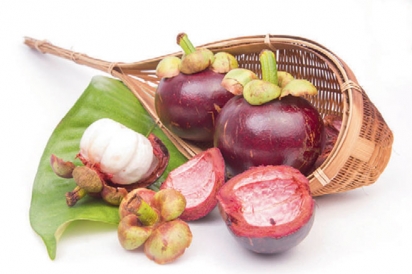What's Your Perfect Summer Fruit?
In South Florida our warm and humid Caribbean climate is perfect for growing tropical fruit in the home garden - an edible landscape full of wonder and exotic, tropical flavors of sugarcane and spice.
The sultry breezes and warm, bathing sunshine coax out a deep sweetness in fruits, and there are tastes and uses for everyone – all cultures, traditions and rituals. We have all this without the use of dangerous chemicals, relying instead on good genetics of our crops, climate and education. Innovations and tradition move in concert with a changing climate and world, making the summer fruit alive and well in South Florida.
But what should the fruit-savvy Floridian grow? Don’t ask me. Instead, look within yourself. What do you like? What are you capable of? What about your time commitment to these fruit? The dilemma lies in the dedication of your home garden space and the compatibility with your time and lifestyle. There is no right or wrong, just a decision about what to plant, where to plant it, how to take care of it and ultimately how to use it.
MYRIAD CHOICES
From blueberries to bananas, we can grow hundreds of home garden fruit that will provide a tasty complement to the kitchen table for years to come. As example, let’s take a snapshot of the fruit trees in my Homestead abode. Mangos, avocados, coconuts, black sapote, mangosteen, miracle fruit, mamey sapote, sapodilla, persimmon, banana, Malay apple, canistel, jackfruit, carambola, loquat, longan, blueberry, jaboticaba, papaya, kwai muk, cherry of the Rio Grande, grumichama, darling plum and hog plum all grow side by side and from top to bottom throughout my one-acre homestead. Some grow in the ground, others in containers, and they spread their bounty through the warm months of summer. The edible landscape lends itself to ambulatory discovery of tastes and texture, supplementing the diet and the home budget alike.
You will note both understatement and omission in the preceding list. Mangos, for example, represent a large and varied assortment of cultivars suited to my tastes and mood. Avocados lack complexity, but excel in their spreading of the season. There are no citrus on the list and this stems from an unwillingness to fight the persistent and lethal diseases of these crops that currently plague our tropical paradise. Rest assured, when we have resistance, the lime, the orange, the tangelo and the grapefruit will be welcomed back after their cruel, extended absence. The lychee does not appear, much to the chagrin of my hungry children. The decision, purely horticultural, grows out of my unwillingness to devote valuable home garden space and time to a tree that refuses to do what I want: namely, fruit reliably. I will stand with the others, fruit that respond to my brand of horticulture and care. Many of these fruit trees pull double duty, as ornamentals and edible contributions, and they serve as anchors for orchids, bromeliads and ferns.
SAVOR SUMMERTIME
But this is only a portrait of my tastes and needs and those of my family. Everyone must find their own summer fruit equilibrium that matches the available light, soils and willingness to work in the heat. The decisions are not life and death. When June arrives in South Florida, living is easy when it comes to fruit. The mangos, the mamey sapote, the sapodilla and all of their yardmates make their appearance. Afternoons are for slow strolls throughout the garden to graze on the landscape. Do not miss a thing. Take advantage of all that our climate has to offer. Experimentation is welcome and change celebrated. The summer fruit is growing old with us, comfortable and reassuring companions on our journey of life.
{ Mangosteen: “An Expensive Curiosity” }
Despite its name, the mangosteen (Carciniamangostana) is not related to the mango. Found mainly in Southeast Asia, the purple, tangerine-sized fruits have a thick rind that covers juicy, white flesh that is sweet and slightly acid. Their luscious flavor makes them one of the most esteemed tropical fruits. On the cover of the new Fruits of Eden by Amanda Harris, plant explorer David Fairchild is pictured examining a mangosteen. He described it as a fruit that “melted in the mouth like the most delicate plum would and it reminded me of all sorts of flavors from pineapple to vanilla with a suggestion of something that I have never been able to find in my category of flavors.”
The slow-growing tropical evergreen, however, is not well suited to South Florida, not tolerating cold snaps or limestone soils, though some experts have been successful. “I collected mangosteen seeds in Borneo in 1986, before I went to grad school,” says Dr. Campbell. “The trees were planted in the pavilion [at Fairchild], and fruit each year right around or after the mango festival. This year we have a big crop.” Campbell, who grows his mangosteens in coconut coir and waters it with rain water.
His father, Carl W. Campbell, said the mangosteen in Florida “is destined to remain only an expensive curiosity because of the special care which must be given for the plants to grow well.” In Fruits of Warm Climates, Julia Morton also wrote about difficulty growing mangosteens: “Despite the oft-repeated Old World enthusiasm for this fruit, it is not always viewed as worth the trouble to produce. In Jamaica, it is regarded as nice but overrated; not comparable to a good field-ripe pineapple or a choice mango.”
See mangosteen trees at the new Asian Pavilion at Fruit and Spice Park and the William F. Whitman Tropical Fruit Pavilion at Fairchild Tropical Botanic Garden.






